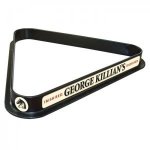Ideally, balls are perfectly matched, racks are perfectly triangular, and they're both perfectly matched to each other. Unfortunately, that's rarely the case. Racking well is really about managing the interplay between the balls and the rack itself. The short answer is, there is no one 'right' way to orient a plastic rack. The long answer is, well...long

Balls wear unevenly with age, and sometimes balls from different sets get mixed together over time. Both factors cause unwanted gaps in certain racking configurations, and gaps usually prevent the balls from spreading very well because of less efficient energy transfer.
If you see gaps, look for a slightly bigger or smaller balls that are screwing things up, and try to put them on corners where they can freeze against the two balls they're touching (more than two adjacent balls is where the problem starts). Sometimes gaps are unavoidable, and then it's a matter of deciding where they do the least damage. Here are some examples of bad gaps:
- Open Break Games: Two gaps behind the center ball are the worst locations when the largest spread is desirable since they rechannel the energy around the center ball and back into it causing an 'implosion' rather than an 'explosion'. The worst case is when the money ball that's required to be in the center is undersized and can't be moved to a better location (try not to swap it with the one on the next table that's a better fit when they aren't looking
 ).
).
- Winning Center Ball Games: A single gap behind the winning center ball can cause it to shoot out towards the corner on the side that the gap is on. This is most dangerous with racks like 9-ball compared to a full 8-ball rack. It often causes an immediate win in a corner, either directly or caroming off another ball (some rules disallowing winning on the break in certain pockets to mitigate this). In rotation games, it can also leave an easy combo for later, and in 8-ball, it can cause both players problems by blocking a pocket with the 8. (see Joe Tucker's outstanding Racking Secrets DVDs for more detailed rack reading info.)
- Straight Pool: Gaps in the bottom row are the least desirable on the opening break since you're hoping for only the bottom two corner balls to shoot out to the rails and back into the stack without disturbing anything else. Playing safe when the other 14 are re-racked later in the game are another matter, and depend on where the CB is located relative to the rack.
- One Pocket: Gaps along the side you're hitting the stack on (i.e. your opponent's side) are worst because they can cause the corner ball to move towards your opponent's pocket and sell out a shot. They can also cause the CB to strike a ball that's popping out prematurely and carom into your opponent's pocket for a scratch.
All racks can be misshapen through use and/or sloppy manufacturing. Plastic is the most susceptible, but wood can be a problem, too. They frequently bow outwardly (or even inwardly!) in different amounts on different sides,
or even different amounts on the same side depending on which side is up.
Depending on the distortions caused by mismatched balls, this isn't always a problem! Usually, there's a best match, and you just need to experiment with all 6 possible rack orientations as to which gives the best fit. It doesn't take long to test either: just flip it around in each orientation while quickly rolling the rack around slightly with the balls pressed together, looking for the telltale rolling balls that indicate gaps (ideally, they should slide without moving when they're all frozen).
Even precisely manufactured metal racks like the Delta-13 can be less effective than poorer quality ones in certain situations because the balls can't freeze when the triangle is too perfect (tip: go look for an old crappy rack to try if you're having trouble getting a good rack with a Delta).
Robert
p.s. Sometimes the balls will freeze, but the head ball will stick to the rack and pull away when you try to remove it. That indicates crud on the inside of the rack where it touches the ball, which can be wiped off with a little water or hand sanitizer.
